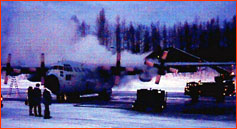 |
 |

|
The Storm Pipe February 6, 1998 By Mark Hoover previous | next I should have sensed that something was wrong. At 12:05 pm yesterday, the airline upgraded me from steerage to first class, no charge, for my afternoon flight to Alaska - the starting point for a journey into the jetstream . This is no small matter on a nine-hour flight. For five minutes, I debated whether I would have the hors d'ouevres before or after the movie. And then at 12:10 pm, meteorologist Nick Bond called and said today's research flight over the Gulf of Alaska had been cancelled. El Niño got me again. Nick and his colleagues, Mel Shapiro and Rolf Langland, have been conducting research this winter from Anchorage and Honolulu. (Mel's getting the suntan, and Nick's getting the frostbite.) On Monday, you recall, we flew with CALJET out of Monterey to find out what an El Niño winter storm looks like from the inside, as it approaches the coast. Nick and the rest of the NORPEX crew look at the other end of the storm pipe, where the storms form in the north Pacific, thousands of miles away. They are particularly interested in how upper level winds and the jetstream change the path that these storms travel.
That's why I was on my way to Anchorage. We had planned to join Nick Bond
in an Air Force C-130 turbojet to investigate the jetstream, and the winds
Nick said that a new pattern of intense storm generation has emerged in the last few weeks, an ideal opportunity for the research NORPEX has been conducting. But the weather (as well as the grueling schedule) has been beating up the planes. The plane we were to fly on tomorrow is down for repairs, and won't be fixed in time. I think the real reason for the cancellation is that Nick's feet couldn't take another 10 hours standing in the frosty back end of the military plane. Without insulation, the plane's metal floor stays around zero degrees, and the only thing you have to look forward to is a cold Air Force lunch. Such are the sacrifices made in the name of science. This may be a blessing in disguise. Because of the dramatic southerly shift in the jetstream this past week, the NORPEX researchers are right now considering relocating the flights to Portland, Oregon. We may get another shot at the jetstream this Tuesday out of Portland, just in time for another huge storm coming in, and before I head to warmer climes—Ecuador and the Galapagos Islands—and the heart of El Niño. previous dispatch | next dispatch | table of contents Photo: USAF Anatomy of El Niño | Chasing El Niño | El Niño's Reach Dispatches | Resources | Mail | Site Map | El Niño Home Editor's Picks | Previous Sites | Join Us/E-mail | TV/Web Schedule About NOVA | Teachers | Site Map | Shop | Jobs | Search | To print PBS Online | NOVA Online | WGBH © | Updated November 2000 |
 that nurture the storms pounding the west coast. Changes in these 200 mph
rivers of air that circle the earth in higher latitudes are what make an El
Niño winter a fearsome thing.
that nurture the storms pounding the west coast. Changes in these 200 mph
rivers of air that circle the earth in higher latitudes are what make an El
Niño winter a fearsome thing.